Lecce’s captivating Baroque architecture has earned it the moniker "Florence of the South." From the ornate grandeur of the Basilica di Santa Croce to the imposing majesty of the Duomo di Lecce, this Italian city’s historic center is a harmonious blend of religious monuments, public squares, and ancient Roman remnants. Visitors can enjoy Lecce’s rich cultural heritage, uncovering the artistic gems that define its unique identity. Whether you’re drawn to its vibrant gastronomic scene or its hidden architectural wonders, Lecce promises to enchant and captivate those who venture beyond its striking facades.
Key Points
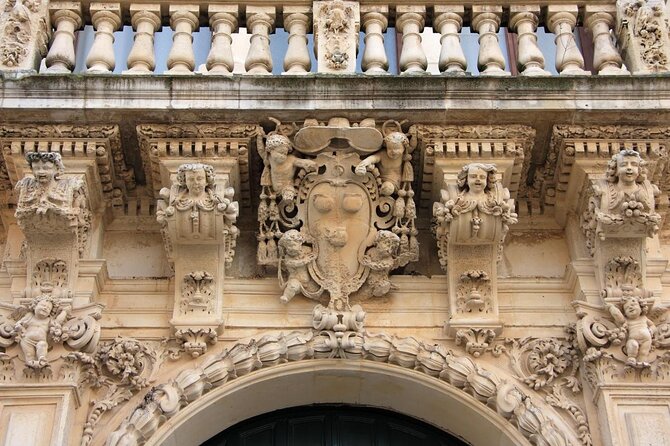
- Lecce’s stunning Baroque architecture is exemplified by the ornate Basilica di Santa Croce, Duomo di Lecce, and Palazzo dei Celestini.
- Lecce’s historic city center features winding cobblestone streets, lively piazzas, and ancient Roman ruins blending past and present.
- Taking in Lecce’s cultural heritage allows visitors to appreciate the intricate stone carvings, grand porticos, and sacred spaces of its iconic monuments.
- Lecce’s thriving food culture offers iconic regional dishes like orecchiette pasta and traditional pastries that define its gastronomic heritage.
- Navigating Lecce’s vibrant streetscapes unveils a harmonious blend of Baroque architecture, bustling piazzas, and hidden gems waiting to be discovered.
Lecce’s Baroque Architectural Masterpieces
Lecce’s Baroque architectural masterpieces are a testament to the city’s rich cultural heritage, showcasing intricate facades, ornate sculptures, and awe-inspiring churches that captivate visitors.
The Basilica di Santa Croce, with its ornate and elaborate façade, is a prime example of Lecce’s Baroque splendor.
The Duomo di Lecce, the city’s magnificent cathedral, boasts a striking Baroque exterior and an impressive interior adorned with intricate carvings and stunning frescoes.
The Palazzo dei Celestini, a former monastery, features a breathtaking courtyard surrounded by delicate Baroque details.
As visitors wander through Lecce’s historic streets, they’re enveloped in the city’s Baroque charm, a unique blend of ornate elegance and Italian artistry.
Want to dig deeper into Lecce? We've also reviewed these city tours
Exploring Lecce’s Historic City Center
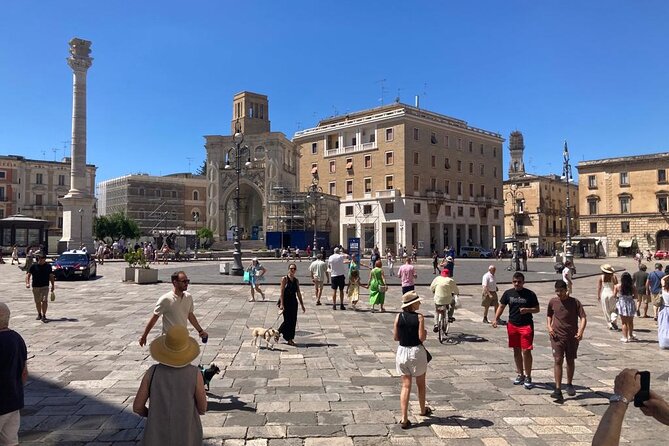
Beyond the dazzling Baroque architecture, Lecce’s historic city center invites visitors to enjoy the rhythm of daily life.
Winding cobblestone streets lead to lively piazzas, where locals gather to sip coffee and banter, offering glimpses into the city’s vibrant culture.
The Piazza del Duomo, with its impressive cathedral and bell tower, is the heart of the old town, while the Piazza Sant’Oronzo, named after the city’s patron saint, showcases the ancient Roman amphitheater.
Strolling through these picturesque squares, one can’t help but feel the pulsing energy of Lecce, a city that seamlessly blends its rich past with the lively present.
Taking in Lecce’s Cultural Heritage
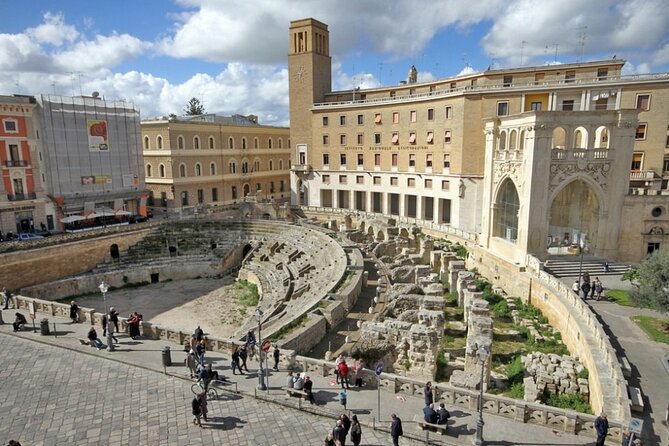
As visitors explore Lecce’s cultural heritage, they discover a city rich in religious and artistic treasures that reflect its storied past. The Basilica of Santa Croce, a stunning example of Baroque architecture, captivates with its intricate stone carvings and elaborate facade, inviting visitors to step inside and marvel at the ornate interior.
Nearby, the Duomo di Lecce, the city’s imposing cathedral, stands as a testament to the region’s deep Catholic roots, its towering bell tower and grand portico commanding attention from the Piazza del Duomo.
Lecce’s cultural heritage also includes:
- The Roman Amphitheatre, a well-preserved relic of the city’s ancient past
- The Palazzo dei Celestini, a grand 17th-century palace now housing the provincial government
- The Church of San Matteo, renowned for its unique Baroque-style facade
- The Museo Faggiano, a museum showcasing the city’s archaeological and artistic treasures.
Experiencing Lecce’s Culinary Delights
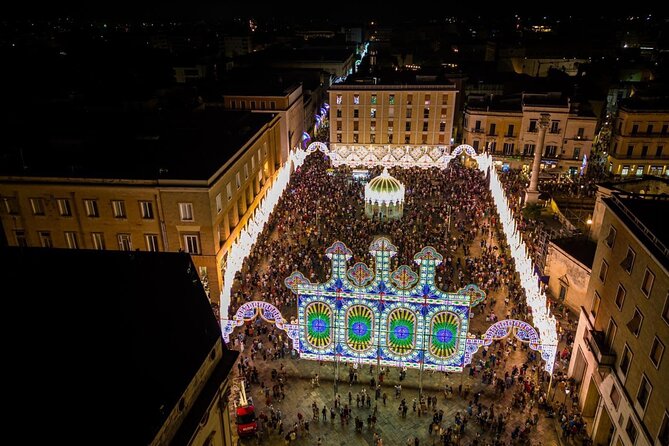
Visitors can savor Lecce’s renowned culinary delights, from the region’s iconic orecchiette pasta to the sweet-and-sour flavors of the traditional puccia sandwich.
Orecchiette, with its distinctive ear-shaped form, is a local specialty that’s often served with a savory sauce of broccoli rabe, anchovies, and chili peppers.
The puccia, a round, flatbread stuffed with cured meats, cheeses, and vegetables, offers a perfect balance of textures and tastes.
Lecce’s thriving food culture also features a variety of pastries, like the pasticciotto, a flaky pastry shell filled with a rich, creamy custard.
Whether indulging in a leisurely lunch or a quick snack, visitors can enjoy the authentic flavors that define Lecce’s gastronomic heritage.
Discovering Lecce’s Religious Monuments
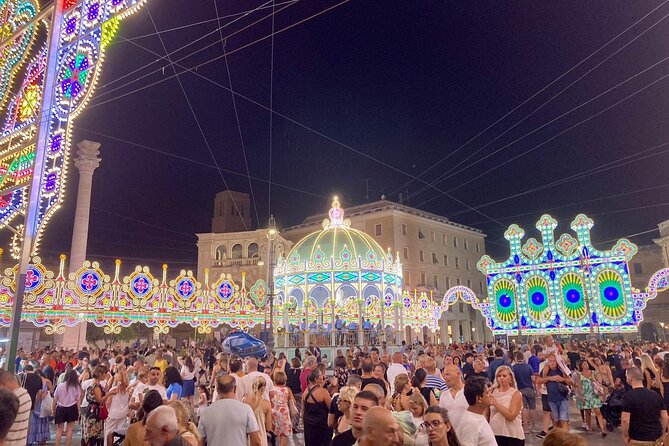
Lecce’s religious monuments stand as a testament to the city’s rich history and deep-rooted faith. From the awe-inspiring Basilica di Santa Croce to the intricate details of the Duomo, these architectural marvels captivate visitors with their ornate Baroque designs.
The intricate facade of the Basilica di Santa Croce, boasting an intricate web of stone carvings and sculptures.
The stunning rose window adorning the Duomo, casting a kaleidoscope of light onto the ornate interior.
The ornate bell tower, or Campanile, towering above the city and offering panoramic views.
The exquisite frescoes and marble sculptures that adorn the walls and ceilings of these religious sanctuaries.
Exploring these sacred spaces, one can’t help but be mesmerized by their grandeur and beauty.
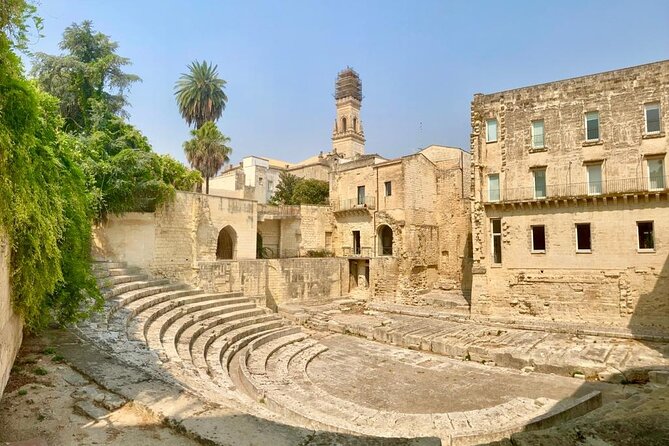
Beyond the religious monuments, Lecce’s vibrant streetscapes captivate visitors with a harmonious blend of Baroque architecture, bustling piazzas, and charming cafes.
Meandering through the historic center, one is immersed in the city’s lively pulse, where ornate palaces, intricate stone carvings, and lively locals contribute to an enchanting atmosphere.
The Piazza del Duomo, with its stunning cathedral and bell tower, serves as the heart of the city, drawing crowds who bask in the historic ambiance. Nearby, the Piazza Sant’Oronzo showcases the ancient Roman amphitheater, now a popular gathering place.
Strolling through the winding streets, one discovers quaint boutiques, artisan workshops, and tempting gelateries, offering a taste of Lecce’s vibrant cultural tapestry.
Uncovering Lecce’s Hidden Gems
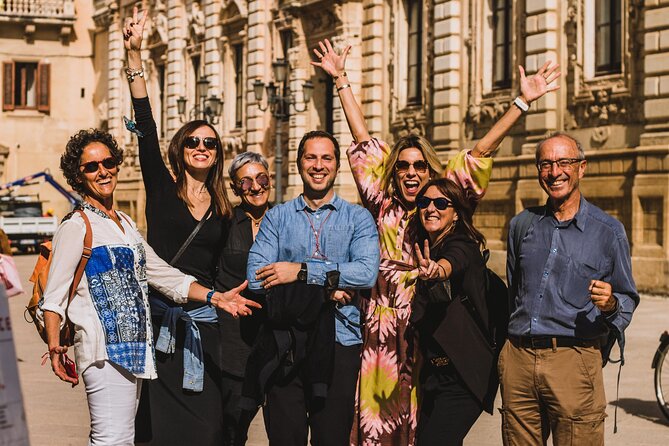
While the city’s grand Baroque architecture and lively piazzas captivate the senses, Lecce’s hidden gems lie waiting to be discovered by the discerning traveler.
Tucked away down narrow side streets and in lesser-known corners, these enchanting treasures offer a more intimate glimpse into the city’s rich cultural tapestry.
Explore the charming Basilica di Santa Croce, a masterpiece of Lecce Baroque with intricate stone carvings adorning its façade.
Explore the tranquil Chiostro dei Celestini, a serene 16th-century cloister tucked away from the bustling streets.
Explore the quaint Piazza Sant’Oronzo, home to a well-preserved Roman amphitheater and the iconic Colonna di Sant’Oronzo.
Explore the hidden artisan workshops where local craftspeople continue centuries-old traditions of lace-making and ceramics.
Planning Your Lecce Adventure
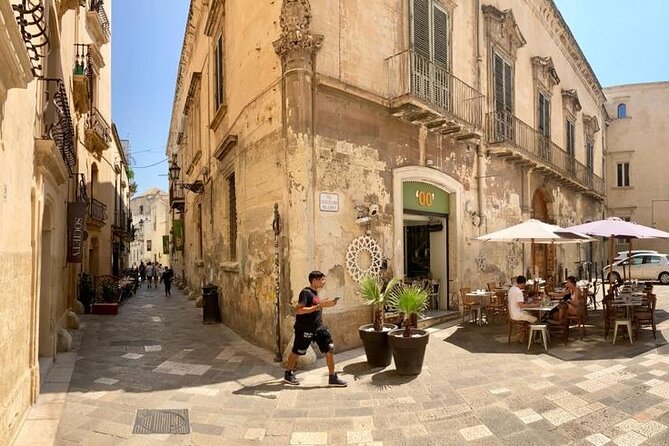
Crafting the perfect Lecce adventure requires careful planning to make the most of your time in this captivating city.
Whether you’re seeking to learn about the city’s rich Baroque heritage or uncover its hidden gems, a well-curated itinerary can unlock the full breadth of Lecce’s cultural treasures.
The guided tour outlined in the knowledge section provides an excellent starting point, offering a comprehensive introduction to the city’s architectural marvels and historic sites.
By securing your spot in advance, you can ensure a seamless experience and make the most of your time in Lecce.
With its convenient meeting point and end location, the tour streamlines your exploration, allowing you to delve deep into the city’s Baroque splendor.
Frequently Asked Questions
What Is the Maximum Group Size for the Tour?
The tour has a maximum group size of 15 travelers. The tour logistics specify that the tour is limited to a maximum of 15 participants.
Is There a Dress Code for the Tour?
There is no explicit dress code for this tour. However, visitors are advised to dress comfortably and respectfully, as they’ll be entering churches and other religious sites during the experience.
Can I Bring My Own Food and Drinks?
Guests are not allowed to bring their own food and drinks on the tour. The tour includes coffee or tea, as well as entrance tickets to churches and museums. Bringing outside items is not permitted.
Are Photography and Video Recording Allowed During the Tour?
Participants are generally allowed to take photos and record video during the tour. However, they should be mindful not to disrupt the experience for others. Some restrictions may apply at certain sites, so it’s best to check with the tour guide.
Is There an Option to Customize the Tour Itinerary?
The tour doesn’t offer an option to customize the itinerary. The set tour details include visiting churches, museums, and landmarks in Lecce. Travelers must follow the pre-determined schedule, though the tour can be booked for private groups.
Recap
Lecce’s captivating blend of Baroque architecture, rich cultural heritage, and mouthwatering cuisine make it a must-visit destination in Italy’s south.
Visitors can enjoy the city’s timeless beauty, from the grand religious monuments to the hidden artistic gems tucked away in its vibrant streetscapes.
With its welcoming atmosphere and wealth of discoveries, Lecce promises an unforgettable journey through the ‘Florence of the South.’
More City Tours in Lecce
More Tour Reviews in Lecce
- Typical Salento Gluttony in a House by the Sea in Lecce
- 1 Hour Walking Tour The Ancient Jewish Quarter in Lecce
- Santa Maria Di Leuca Private Tour, Right at the Tip of Italys Heel
- Hike & Trekking: Otranto, Baia Orte and the Palascia Lighthouse
- Discovering Lecce Walking Tour With Pasticciotto Tasting
- The Baroque Style & Gardens in Lecce
Not for you? Here's more things to do in Lecce we have recnetly reviewed
- SENSORY TASTING OF EXTRA VIRGIN OLIVE OIL IN LECCE
- Santa Maria Di Leuca: Capo Di Leuca Boat Tour
- Explore the Beauty of Porto Selvaggio Bike Tour
- Lecce: City Pass
- Lecce Unveiled: 2-Hour Guided Baroque Adventure
- The Court of the Falconer Masseria Mazzetta
- Lecce Guided Tour With Underground Discoveries
- 4 Best Canoe And Kayak Experiences In Lecce
- 5 Best Dining Experiences In Lecce
- 5 Best Dinner Tours In Lecce
- 5 Best Shopping Tours In Lecce
- 4 Best Lunch Experiences In Lecce
